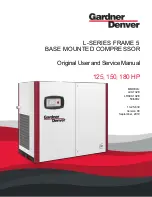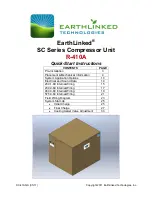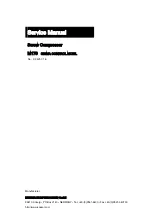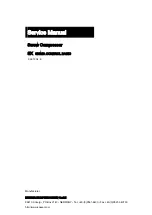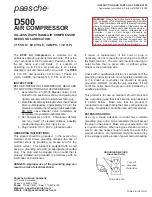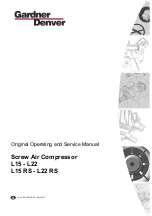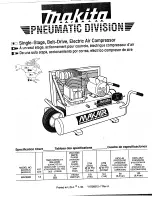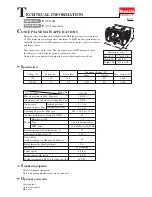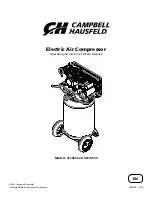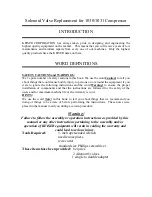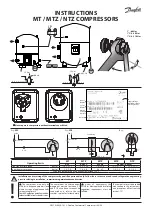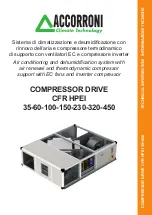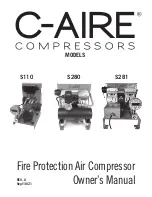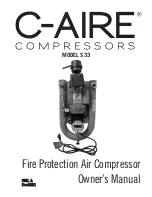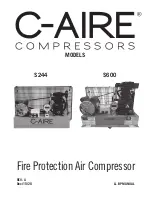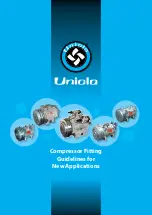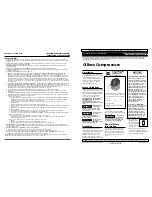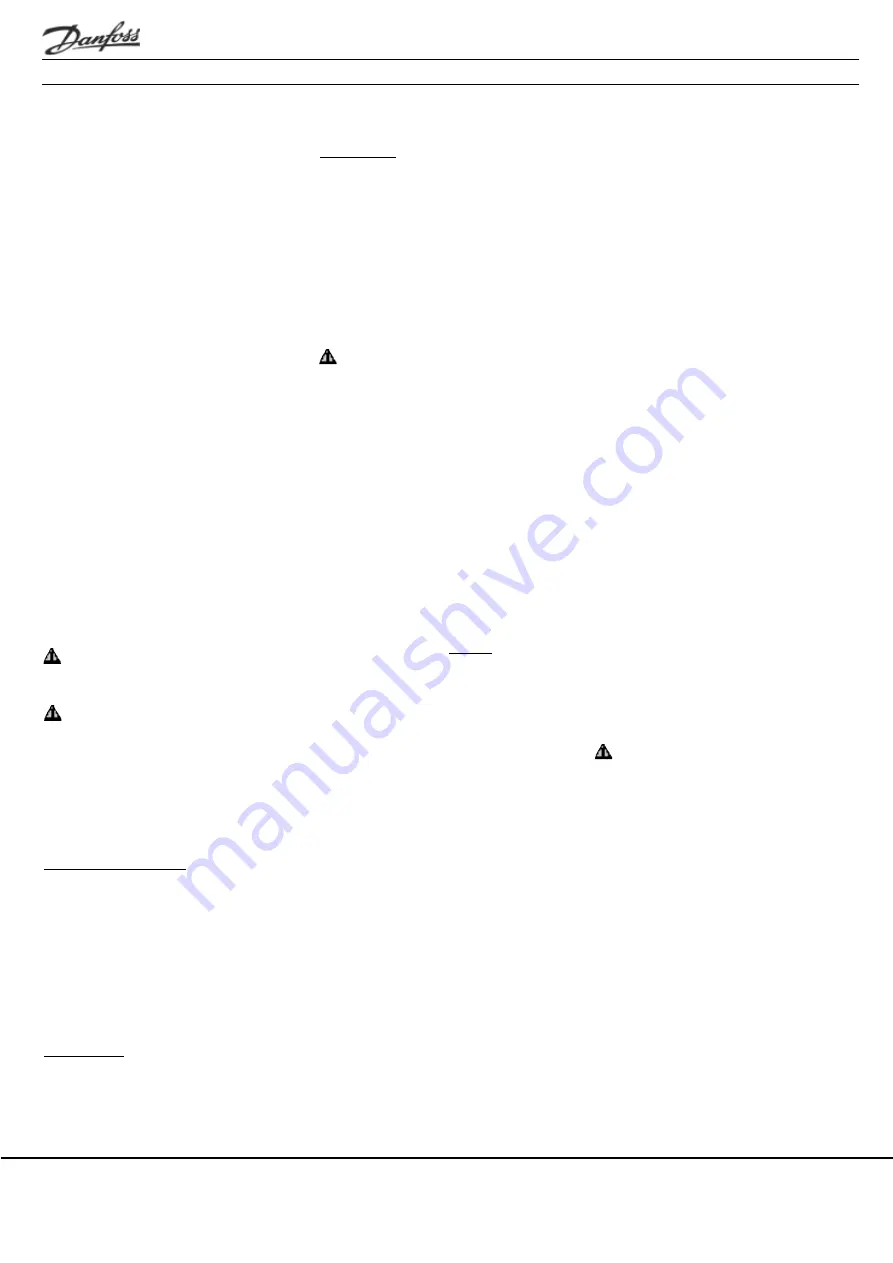
4
8510197P01-D © Danfoss Maneurop
06-2002
Instructions
8 - Filling the system
·
Before charging the refrigerant, verify that the
oil level is between 1/4 and 3/4 on the
compressor oil sight glass (when mounted)
and/or ensure that the oil charge of the original
compressor is sufficient as regards system
dimension and piping design:
o An additional quantity of oil might be necessary
for line lengths (back and forth) in excess of
20 m.
o In the event additional oil is required, use
only an approved lubricant (refer to the
“Introduction” section of this manual).
o An oil sight glass compressor model is
recommended for split systems and remote
condenser installations.
For all information necessary on adding oil
to the compressor, refer to TI bulletin 1-025.
·
Make sure the refrigerant used to fill the sys-
tem is compatible with compressor design. Refer
to the “Introduction” section of this manual for an
approved list of refrigerants.
·
Compressor switched off: The liquid refriger-
ant is charged into the condenser and/or liquid
receiver in the liquid phase (compulsory for
refrigerant blends). The charge must be as close
to the nominal system charge as possible in
order to avoid both low pressure operations and
excessive superheating at start-up. Throughout
this operation, both compressor service valves
must remain closed.
·
Remember that vapor-charging is only
appropriate for pure refrigerants, such as R22.
·
To the extent possible, maintain the refrigerant
charge below the refrigerant charge limit for the
compressor model. Above this limit, install a
system, such as a pump-down cycle or suction
line accumulator, to prevent against liquid flood-
back into the compressor.
·
Be sure that the refrigerant charge is suitable
for both winter and summer operations.
9 - Verification before commissioning
Ensure that all service valves are in the open
position before start-up. A closed discharge or
suction service valve may cause serious damage
to the compressor and/or compromise safety de-
vice operation, thereby resulting in potential in-
jury to personnel.
·
Check that all safety devices are operational
and properly set (safety pressure switch set point,
mechanical relief valve if necessary, etc.). Make
sure that these devices comply with both
generally - and locally - applicable regulations and
standards (e.g. EN378).
·
When using high-pressure switches or relief
valves, the setting must not exceed maximum ser-
vice pressure of any system component.
Refer to the Application Guidelines for relevant
compressor pressure safety limits.
·
A low-pressure switch is recommended to
prevent operation under vacuum. Use a minimum
setting of 1.2 bar (absolute).
·
Verify that all electr ical connections are
properly fastened and in compliance with local
safety regulations.
·
When a crankcase heater is required (refer to
the Application Guidelines), ensure that it has been
energized for a minimum of 12 hours
before initial start-up and/or during prolonged
shutdown periods.
connection.This recommendation allows avoiding
excessive pressure losses.
Moisture level:
At the time of commissioning, system moisture
content may be as high as 100 ppm. During
operation, the liquid line filter dryer must reduce
this level to < 20 ppm.
Additional notes:
·
To improve moisture removal, the temperature
of the system should not be lower than 10
°
C.
·
A proper vacuum procedure is even more
important with HFC and polyolester lubricant than
it has “traditionally” been with HCFC (R22) or CFC
and mineral oil.
·
For further details, please refer to TI bulletin 1-026.
Do not use a megohmeter or apply power to
the compressor while it is under vacuum, as this may
cause motor winding damage (motor burn-out).
7 - Electrical connections
·
Make sure the main power supply to the sys-
tem has been switched off and isolated, in
accordance with applicable regulations, before
performing any electrical connection.
·
Refer to Figs. 7, 8, 9 for wiring connection
details with respect to the various motor codes.
·
Note that Performer
®
compressors SM/SZ 115
-125- 160 - 175 - 185 are provided with a bimetallic
single pole single throw thermostat which is located
in the motor windings. Because the
thermostat is an automatic reset device, it must
be wired in a lockout safety circuit with a manual
reset to restart the unit (refer to Fig. 8).
For over-current protection, an external manual
reset overload protector must be used.
·
Note that Performer
®
compressors SM/SZ 084
-090- 100 - 110 - 120 - 161 are protected against
overheating and overloading by an internal safety
motor protector. However, an external manual re-
set overload protector is recommended for
protecting the circuit against over-current (Fig . 7).
S240. 300 motors are protected by an external
module protecting against phase loss/reversal,
overheating and high current draw (Fig. 9).
·
The “must trip” value of these overload relays
must be set in accordance with power line sizing
and design and shall never exceed the “A max.” value
stamped on the nameplate.
·
Performer is a unidirectional machine and will
only pump refrigerant when properly phased. The
S084 to S185 compressors incor porate an
internal reverse rotation protection to safeguard
the compressor. If reverse rotation occurs, shut
the compressor down and connect phases to the
proper terminals. If reverse rotation is not halted,
the compressor will cycle off on the internal
motor protection. For the S240 and S300 com-
pressors, a phase sequence controller function is
built into the external motor protection module
(Refer to Fig. 9).
·
The power supply connection is made by
means of a T-block connector (screw type 4.8 mm
- 3/16”) and the thermostat connection is made
by means of a spade connector (1/4”-AMP-AWE).
For screw type connections, note that the maximum
tightening torque is 3 N-m.
·
A 5-mm earth terminal screw is provided in the
compressor junction box for the grounding connection.
All electrical components must be selected as
per local standards and compressor requirements.
a mixture of nitrogen and the refrigerant to be used
in the system, a helium leak test and/or a deep
vacuum test.
·
The test should be long enough in duration to
ensure the absence of any slow leaks in the
system.
·
Use tools specifically designed for detecting leaks.
·
The low side test pressure must not exceed
25 bars.
·
For high side test pressure recommendations,
please refer to the Application Guidelines.
·
Whenever the compressor is equipped with
suction and discharge shut-off valves, these valves
are to remain in the closed position while perform-
ing the leak test (compressor leak test already
performed in the factory).
·
Should a leak be discovered, proceed with
repair steps and repeat the leak detection.
·
When a deep vacuum leak detection test is
selected, observe the following:
1) The level to reach is 500
µ
m Hg.
2) Wait 30 min.
3) If pressure increases rapidly, the system
is not air tight. Locate and repair leaks.
Restart the vacuum procedure, followed by
steps 1, 2, etc.
4) If pressure increases slowly, the system con-
tains moisture inside. Break the vacuum with ni-
trogen gas and restart the vacuum procedure, fol-
lowed by steps 1, 2, etc.
5) Connect the compressor to the system by
opening the valves.
6) Repeat the vacuum procedure, followed
by steps 1, 2, etc.
7) Break the vacuum with nitrogen gas.
8) Repeat the vacuum procedure, steps 1,2;
a vacuum of 500
µ
m Hg (0.67 mbar) should be
reached and maintained for 4 hours. This pres-
sure is to be measured in the refrigeration sys-
tem, not at the vacuum pump gauge.
Do not use a megohmeter or apply power to
the compressor while it is under vacuum, as this
may cause motor winding damage
(motor burn-out).
Do not use colored leak detection fluids.
Do not use chlorofluorocarbon in leak testing
systems designed for HFC fluids.
6 - Vacuum procedure
Whenever possible (if shut-off valves are present),
the compressor must be isolated from the
system. It is essential to connect the vacuum pump
to both the LP & HP sides, in order to avoid
dead-ending system parts.
Recommended procedure:
1) Once leak detection has been completed,
2) Pull down the system under a vacuum of 500
µ
m Hg (0.67 mbar).
3) When the vacuum level of 500
µ
m Hg has been
reached, the system must be isolated from the pump.
4) A vacuum of 500
µ
m Hg (0.67 mbar) has to be
reached and maintained for 4 hours. This
pressure is to be measured in the refrigeration
system, not at the vacuum pump gauge.
If pressure increases, restart the leak-detection
procedure (refer to the “Leak detection” section
of this manual if necessary).
Vacuum pump:
A two-stage vacuum pump with gas ballast
(0.04-mbar standing vacuum) shall be used;
its capacity is to be consistent with system volume.
Never use the compressor as a vacuum pump.
It is recommended to use large-diameter connec-
tion lines and to connect these lines to the shut-
off valves, rather than to the Schr ader

















